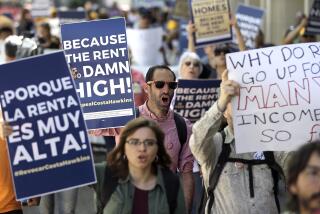Renter Coalition Seeks Members, Return to Power
- Share via
Santa Monicans for Renters’ Rights, the organization that created the city’s rugged rent control law but ultimately lost control of City Hall, is reorganizing in hopes of returning to power in the 1986 election.
The liberal coalition, composed of three local political groups, will become a general membership club in the summer when its leaders hold a convention to elect a steering committee and solicit memberships.
City Councilman Dennis Zane, a founding member of Santa Monicans for Renters’ Rights, said the move is designed to help the organization win new support and strengthen its political role. Leaders also hope to improve management of the 7-year-old organization, which lost the council majority last year after Councilwoman Dolores Press failed to qualify for the ballot.
Zane said the organization traditionally receives financial contributions from 3,000 to 4,000 supporters at each election. Under general membership, Zane said he hoped those supporters would become full-time members and that the club also would be able to attract people who had voted for renters’ rights candidates but never participated in the organization.
More Participation Sought
“SMRR has a very large body of talented and experienced leadership,” Zane said. “I think that this change will bring that leadership together more regularly in one room. It will also open up leadership roles for more people, and that will increase the opportunity for new people to participate.”
While Santa Monicans for Renters’ Rights traditionally mobilizes large numbers of volunteers and voters for elections, some leaders have privately been critical of the organization’s loose structure. Some leaders questioned whether the organization, with no permanent office, actually served its supporters. Others held that the group was too narrowly focused on rent control. Another common criticism was that SMRR was too insular and had closed itself to new ideas.
Press said the club would try to solve some of those problems by holding regular meetings and lobbying year-round for issues that concerned the membership.
“Thinking about what would happen if we lost rent control was the primary issue on people’s minds,” Press said. “I think that now we can move on and be more concerned about development, doing follow-through, making sure that our commitments . . . are honored and keep track of the bureaucracy.
‘One Step at a Time’
” . . . We have to do things one step at a time. We have to get a staff person capable of raising money. We want to do some tenant counseling. We need to expand that committed renters’ rights group into a much broader public interest group. . . . It’s very important to communicate with your supporters at times other than fund raising.”
In a city where 80% of residents are tenants, Santa Monicans for Renters’ Rights was tailor-made to its constituency. The organization came together in 1978 when senior citizens and young activists affiliated with Assemblyman Tom Hayden’s Campaign for Economic Democracy, the Santa Monica Democratic Club and the Santa Monica chapter of Americans for Democratic Action came together to oppose rising rents and unchecked development.
A year later the organization successfully campaigned for one of the nation’s toughest rent control laws, and in 1981 the renter faction shocked the city’s old political guard by gaining control of City Hall. But the headiness was short-lived.
In 1983, tenant-backed Mayor Ruth Yannatta Goldway was ousted from office by a candidate supported by the All Santa Monica Coalition, a group formed in opposition to SMRR. The coalition captured the additional seat it needed to hold a majority on the seven-member council last year when Press lost her write-in campaign.
Skeptical of Success
Tom Larmore, a leader of the All Santa Monica Coalition, said his organization would not consider adopting general membership because the city has too many special interest groups.
“People have only so much time and they tend to be active in groups that respond to their specific interests,” Larmore said. “To try to overlay a much larger organization probably wouldn’t be successful. I think they’ll end up claiming that they’ve done it, when in fact they’re going to be led by the same people.”
Asked about Larmore’s comments, Zane admitted that SMRR has yet to work out all facets of its plan. Zane said the Campaign for Economic Democracy, which paid for the group’s political headquarters and contributed $32,000 to its campaigns in 1984, probably would continue to be a major presence.
“CED’s members are going to be prominent because it produces more money and more volunteers for elections than any other group,” Press said. “But the people elected to the board are going to be elected by everybody. Therefore, they will have independence. They will not be beholden to any separate group of the coalition. That’s the intention here. The level of influence will be different because the structure will be different.”
More to Read
Sign up for Essential California
The most important California stories and recommendations in your inbox every morning.
You may occasionally receive promotional content from the Los Angeles Times.













